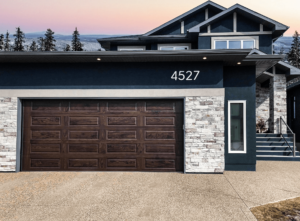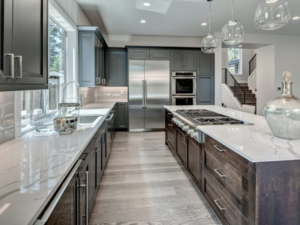San Jose Cabinet Refinishing is a popular renovation option for homeowners looking to update their kitchen. It is cost-effective and environmentally friendly compared to a full kitchen remodel.

When cleaning refinished cabinets, it is important to use gentle chemicals and avoid harsh products that could strip the finish. Also, it is important to conduct regular inspections to identify and address any damage or deterioration.
Cabinet refinishing is an easy way to update your kitchen without breaking the bank. It offers plenty of customization options that can suit any design preference, and it’s a great option for homeowners looking to add value to their home or upgrade their kitchen’s aesthetic without the expense of a full replacement project.
The process involves removing the doors, drawer fronts, and hardware from your existing cabinets, cleaning them to remove grease and grime, then sanding the surfaces to prepare them for the new finish. Once the surface is ready, the primer or paint is applied and a protective sealant or topcoat is applied to the finish. Cabinet refinishing is an affordable and eco-friendly alternative to complete replacement, providing a beautiful transformation that’s sure to impress any future buyers if you decide to sell your home.
With refinishing, the majority of your cabinet components remain intact, which means you can still make changes through other updates such as changing out your hardware, installing new countertops, and upgrading the rest of your home’s décor to complement your newly refreshed cabinets. In addition, you can choose from a wide array of color and finish options to perfectly suit your taste, including timeless white, rich reds, navy blues, or soft greens. You can also opt for a glossy or matte finish to achieve your desired look, and you can even change out the hinges to match your style preferences.
Choosing the right paint and finishing style is an important part of your project, as it will impact both durability and longevity. Lighter finishes are more durable than dark hues and can withstand stains and scratches, which makes them an excellent choice for busy kitchens. Additionally, lighter colors can brighten the space, resulting in an airy and welcoming atmosphere that’s a pleasure to be in every day.
Professional cabinet refinishers have the experience and knowledge to provide a flawless, expert finish that will elevate your space. Additionally, they can work quickly and efficiently to minimize the disruption to your daily routine, saving you valuable time and money.
Longevity
Cabinet refinishing offers a great return on investment, as it extends the life of your cabinets. The new finish protects the cabinets from wear and tear, minimizing damage from spills, moisture, and harsh cleaning chemicals. This helps your cabinets last longer, avoiding costly replacements in the future.
Professionally refinished cabinets, when properly maintained, can last up to 15 years in a residential setting. However, their longevity depends on how often they are used and whether children or pets live in the home. Regularly wiping down cabinets with a mild soap and water solution is the best way to keep them looking great. In addition, addressing small nicks and scratches promptly will minimize their spread. Avoiding the use of abrasive cleaners and avoiding exposure to extreme temperatures will also prolong the lifespan of your cabinets.
The quality of materials used to refinish your cabinets will impact their longevity. For example, flimsy peel-and-stick products from overseas may be prone to delamination, which is the separation of the laminate layers. Choosing high-quality solid wood or quarter-inch laminate can help ensure durability and long-lasting beauty. In addition, using acrylic-latex paint, which dries quickly and resists yellowing, is a great choice for refinishing.
While refacing is less expensive than replacing your cabinets, it can be labor intensive and generate a significant mess. In addition, it may not provide the visual transformation that you want. For these reasons, cabinet refacing is usually reserved for homeowners who are looking to increase their home’s value.
The amount of wear and tear your cabinets experience will also impact their longevity. For example, cabinets in a kitchen that is frequently used will see more daily wear and tear than those in a bedroom or office. Refacing or refinishing your cabinets with high-quality materials can help them last longer, but they will still need to be regularly cleaned and repaired to stay in good condition.
Refinishing your cabinets saves money, increases the value of your home, and provides a custom look. It also eliminates the environmental impact of replacing your cabinets, as reusing existing materials reduces waste and energy consumption. However, it is important to choose a reputable and experienced professional for the job. A poor refinishing job can lead to peeling, cracking, and unsightly spots that diminish the beauty of your cabinets. In addition, the improper removal of old paint can result in uneven surfaces that require frequent repainting.
Easy maintenance
Refinishing your cabinets allows you to keep the integrity of your kitchen’s existing structure, while bringing in a fresh, updated aesthetic. In addition, it’s more cost-friendly than refacing or purchasing entirely new cabinetry. Plus, it’s easy to maintain over time with a little TLC.
Using gentle cleaners and a soft cloth, you can keep your cabinets looking great for years to come. The key is to avoid harsh chemicals or abrasive products that can damage the finish. Regularly wipe down the surfaces, checking for stains and wear. You can also use a wood conditioner to prevent dullness and increase longevity of your cabinetry.
Aside from cleaning the surfaces, refinishing typically involves patching any holes or imperfections in the cabinets. It may involve sanding to create a smooth surface, and applying a primer or paint depending on your preference (latex or oil-based). Expert application techniques ensure that the finish adheres well to the surface of your cabinets, providing a long-lasting, high-quality result.
While refinishing is a viable option for homeowners who want to change the look of their Las Vegas home’s cabinets, it isn’t as transformative as refacing. Refacing is the best choice if you want to completely revamp your kitchen’s style, and it can also add increased functionality.
Before refinishing, your contractor should remove all the cabinet doors, drawers, and hardware from their frames. They should clean all the surfaces thoroughly to make sure there’s no grease or grime on them, and they should sand down any rough areas to prepare them for the new stain or paint. They should then apply a protective topcoat to ensure the finished product lasts longer and protects against moisture and wear.
Refinishing your cabinets is also a more environmentally conscious option than replacing them. Replacing cabinets requires the purchase of new materials, which contributes to waste accumulation and energy consumption. Refinishing your cabinets helps reduce the need for these resources and keeps them out of landfills.
Affordability
Cabinet Refinishing is a smart and budget-friendly alternative to replacing your existing cabinets. It offers endless design possibilities without the high costs and lengthy timelines of a complete renovation.
This method works by maintaining your current cabinet boxes and simply enhancing the surface appearance through re-staining or painting. Unlike cabinet replacement, which requires demolition and installation of new cabinets, refinishing is a less invasive process that can usually be completed within a week or two. This helps keep your home uncluttered and functional during the duration of the project.
Although there are many DIY options for refinishing, hiring professionals is a good idea to ensure efficiency and a flawless finish. They also bring a level of expertise that is hard to replicate through a DIY project, resulting in a more cost-effective outcome. Furthermore, professionals have the tools and experience to handle more complex jobs, such as repairing chipped or cracked doors and drawer fronts.
With refinishing, you’ll have access to an array of color options and can choose from a variety of finishes, including glossy, matte, or distressed. You can even add custom details like glazing or stenciling to create a truly unique look. This allows you to achieve a modern, sleek style or cozy traditional feel without breaking the bank.
Another advantage of refinishing is that it can be more environmentally-friendly than replacing your cabinets. Refinishing conserves your existing materials and avoids adding to landfills, which is a huge benefit for the environment. Furthermore, it saves time and money by eliminating the need for demolition and the purchase of new materials.
However, it’s important to remember that refinishing does limit your customization options. For example, you can’t replace your existing door styles with different ones, and you won’t be able to install concealed hinges. If you’re looking to make significant changes to your kitchen or bathroom, cabinet refacing is a better option. This process involves replacing the cabinet doors and drawer fronts but keeping the existing box structure. It’s an effective way to update your kitchen or bath with a fresh, updated look that’s sure to impress.


